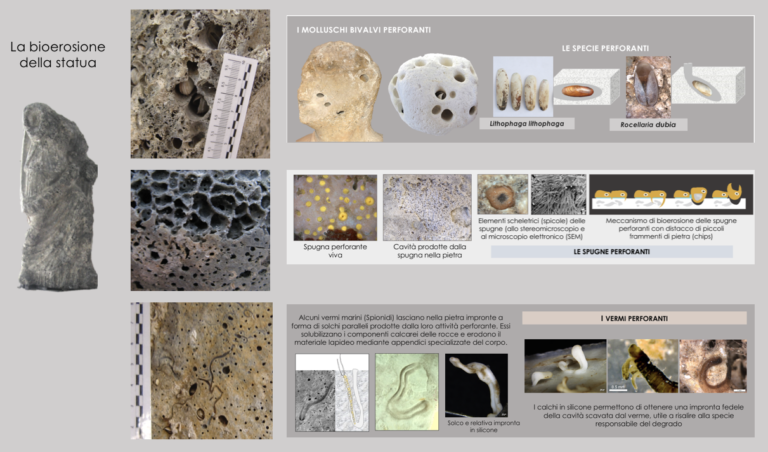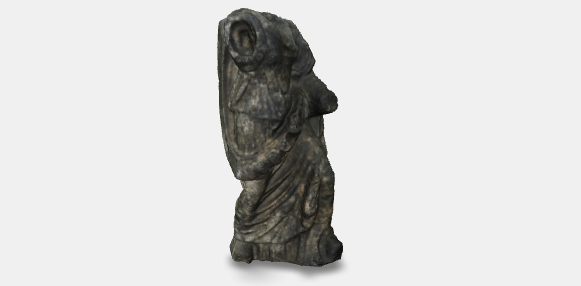This large statue in grey marble was found in Pozzuoli in the waters in front of the acropolis at Rione Terra. Heavily damaged by marine organisms, was initially identified as Victoria, though it represents the goddess Isis, protectress of sailors (Pelagia), in a pose already known from other representations. Unfortunately, the head and the arms, made separately in white marble, are lost.
The statue shows a clear example of degradation of the stone caused by endolithic development of microorganisms and boring organisms. These evident signs include perforations made by bivalves (belonging to the species of Lithophaga lithophaga and Rocellaria dubia) with holes of 1-2 cm, sometimes still preserving the whole shells of the molluscs; sub-globular cavities produced by Cliona sponges, whose effects caused a significant degradation of the marble layer; sinuous grooves dug on the surface by marine worms.
The back of the statue is better preserved, probably thanks to a longer permanence in the sediment than the front side. There are visible remains of fouling animals’ colonisation, such as Thoracica, Bryozoans, bivalves and Serpulidae.

Davidde B., Ricci S., Poggi D., Bartolini M., 2010. Marine bioerosion of stone artefacts preserved in the Museo Archeologico dei Campi Flegrei in the Castle of Baia (Naples), Archaeologia Maritima Mediterranea; 7: 75-115.
Ricci S., Sacco Perasso C., Antonelli, F., Davidde Petriaggi B., 2015. Marine Bivalves colonizing roman artefacts recovered in the Gulf of Pozzuoli and in the Blue Grotto in Capri (Naples, Italy): boring and nestling species. International Biodeterioration & Biodegradation (98) 89 – 100.
Ricci, S., Pietrini, A. M., Bartolini, M., Sacco Perasso, C., 2013. Role of the microboring marine organisms in the deterioration of archaeological submerged lapideous artifacts (Baia, Naples, Italy). International Biodeterioration & Biodegradation 82 (2013) 199-206.
Ricci S., Davidde B., Bartolini M., Priori G. F., 2009. Bioerosion of lapideous objects found in the underwater archaeological site of Baia (Naples). Archaeologia Maritima Mediterranea, 6: 167-188.
Zevi F. (cur.) 2009, Museo archeologico dei Campi Flegrei. Castello di Baia. Napoli: Electa Napoli.



